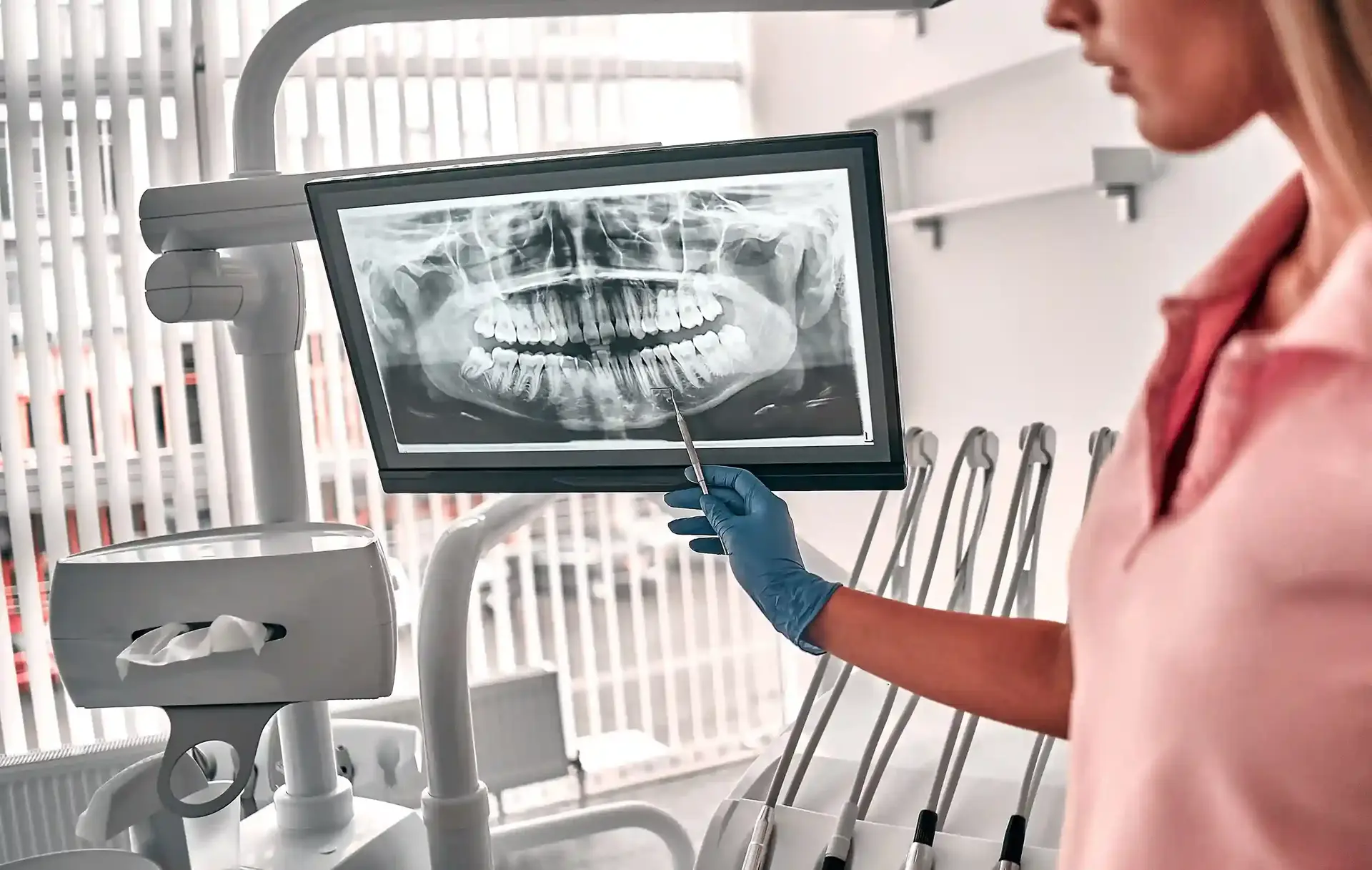The difference between D4341 and D4342 might look small, but choosing the right code is essential if you want the claim to be accepted without delays or downgrades.
Miss a detail and your SRP claim could be downgraded to a prophy (D1110) or denied altogether, even if the clinical notes support the procedure.
Understanding how these codes work and what payers are looking for can make a real difference in how quickly claims are processed and paid.
Since D4341 and D4342 are easy to confuse, identifying where billing issues usually happen can help your team avoid delays, denials, and lost revenue.
Code Definitions
D4341 Dental Code Definition
The D4341 dental code refers to scaling and root planing performed on four or more teeth in a single quadrant of the mouth.
This therapeutic periodontal procedure involves cleaning below the gumline to remove plaque, tartar, and infected tissue, helping treat advanced gum disease.
Proper documentation, such as pocket depths and radiographic evidence, is essential when billing this code to avoid denials.
D4342 Dental Code Definition
The D4342 dental code applies to scaling and root planing performed on one to three teeth in a single quadrant.
This code is used when periodontal disease is localized to fewer teeth that require deep cleaning below the gumline.
Just like D4341, thorough documentation including periodontal charting and supporting radiographs is crucial for successful claim approval.
What is the difference between D4342 and D4341?
As outlined above, the difference between D4341 and D4342 dental codes centers on how many teeth in a single quadrant are treated during scaling and root planing:
The procedure itself is the same, the distinction lies solely in the number of teeth treated.
Using the wrong code or lacking clear documentation to back the code can lead to claim denials or payment downgrades.
How do I bill D4341 and D4342 correctly to get claims paid?
Choosing the right dental code is just part of the dental billing process. To prevent denials or downgrades, your documentation must clearly justify the claim.
For a deeper dive, check out our Clinical Notes Blueprint - a practical guide that helps dental teams master documentation.
Most dental insurance carriers expect to see:
- Periodontal pocket depths of 4mm or greater, depending on the payer’s policy and supporting documentation.
- Radiographic evidence confirming bone loss
- Periodontal charting that matches the number of teeth treated in each quadrant
- Clinical notes showing signs of active periodontal disease, such as inflammation or bleeding on probing
Additionally, ensure you correctly identify the treated area: specify the quadrant for D4341 and tooth numbers for D4342.
For detailed oral cavity codes required for D4342, see the dedicated section below.
If any of this information is missing, even a valid claim can be denied.
What are the common reasons D4341 and D4342 claims get denied?
Most denials for D4341 and D4342 claims stem from incomplete or insufficient documentation supporting the treatment.
Common issues include:
- Missing or incomplete periodontal charting
- Lack of radiographic evidence to verify bone loss
- Clinical notes that fail to document inflammation, bleeding, or other important signs of periodontal disease
- Using a dental code that doesn’t match the number of teeth treated (for example, billing D4341 when only three teeth were treated)
Ensuring your documentation is thorough and accurate helps prevent these common denials.
Want to catch more claim issues before they happen? Explore the most common dental billing errors and how to prevent them.
Can I bill D4341 if three teeth were treated in a quadrant?
No. As previously explained, if you treat one to three teeth, you must use the D4342 dental code.
What is the oral cavity code for D4342 and why is it important?
For D4342, many insurance payers require an oral cavity designation such as:
- UR (Upper Right)
- UL (Upper Left)
- LR (Lower Right)
- LL (Lower Left)
If the oral cavity code is omitted or incorrect, the claim may be rejected.
Since payer requirements vary, always verify the specific documentation and coding rules for each insurance carrier before submitting claims.
Do all insurance companies require the same documentation for D4341 and D4342 claims?
Not exactly.
While most insurance companies expect the core documentation, periodontal charting, radiographs, and clinical notes, some of them have additional forms or specific documentation requirements.
Reviewing payer-specific guidelines before submission can help ensure your claim is processed smoothly.
What are the best practices to prevent D4341 and D4342 claim denials beyond documentation?
When it comes to getting your D4341 and D4342 claims approved quickly, good documentation is essential, but there are other important steps you can take to avoid denials and delays.
1. Verify Insurance Eligibility Before Treatment
Always verify insurance coverage before starting the procedure.
Confirm that their plan covers scaling and root planing, and understand any limitations or requirements.
This can prevent surprises when you submit the claim.
2. Obtain Pre-Authorization When Required
Some insurance companies need pre-authorization for SRP procedures.
Getting approval upfront helps avoid claim rejections because of missing pre-authorization.
3. Use Accurate Fee Schedules
Make sure your billing fees align with the allowed amounts on your patient’s insurance plan.
4. Submit Claims Promptly and Correctly
File your claims within the insurance company’s time limits.
Double-check for correct patient information, codes, tooth numbers, oral cavity designations, and legible clinical documentation attachments.
Simple mistakes here are a huge cause of rejections.
5. Track and Follow Up on Claims
Keep an organized system to track submitted claims. If a claim is denied or delayed, follow up immediately.
Often, denials happen due to fixable errors or missing information, and quick resubmission can save revenue.
6. Train Staff Regularly
Make sure the billing team understands the nuances of D4341 and D4342 codes, documentation standards, and payer-specific rules.
Regular training helps avoid errors and builds consistency.
By paying attention to these details, your practice can reduce claim denials, speed up reimbursements, and strengthen your revenue cycle management.
If your in-house team is overwhelmed, outsourcing dental billing may be the smarter solution.
Are D4341 and D4342 considered specialty procedures?
While SRP is a periodontal procedure, it is not classified as a specialty treatment because it is non-surgical and can often be performed by a dental hygienist.
This means patients usually don’t need a referral to receive this care.
However, some insurance plans, such as certain Medicare or military plans, may require pre-authorization before coverage is approved.
Do D4341 and D4342 require a minimum pocket depth for coverage?
There is no universal minimum pocket depth in the official dental coding guidelines, but most insurance carriers require a pocket depth of at least 4 millimeters for coverage.
Some insurance plans are even stricter, requiring depths of 5mm or more for payment.
Since insurance policies vary widely, it’s best to verify the minimum pocket depth requirements with each payer during insurance eligibility checks.
Are there limits on how many quadrants can be billed in one visit?
Some insurance carriers limit the number of quadrants of SRP you can bill per appointment:
- Certain plans allow billing for all four quadrants in one visit.
- Others only cover two quadrants per visit, and billing more could cause claim denials.
Verifying these rules ahead of time helps you properly schedule treatment and avoid insurance issues.
What should I remember when billing D4341 and D4342 claims?
Beyond correct coding and documentation, keep these points in mind for smoother claims:
- Include full mouth X-rays and a clear periodontal chart with your claim.
- Attach a thorough clinical narrative describing pocket depths, bone loss, inflammation, or bleeding.
- If you can, add a panoramic X-ray to strengthen your claim.
- Always name the quadrant when billing D4341 and the specific teeth numbers for D4342.
- Confirm the number of teeth treated corresponds with the code used - D4341 for 4+ teeth, D4342 for 1-3 teeth.
Adding this detail helps insurance companies understand the necessity of the treatment and speeds claim approval.
Why do insurance companies deny D4341 and D4342 claims?
Insurance companies are increasingly cautious about "upcoding", using a more expensive code than the treatment performed.
Denials often happen because of:
- Lack of proof of bone loss (radiographs must show this).
- Clinical notes missing explanation or X-rays not glued to claim.
- No record of appointment length. Because SRP is a time-intensive procedure, especially for multiple quadrants, insurers may request documentation on how long the treatment took.
- Incorrect coding related to the number of teeth treated.
To avoid these denials, always provide clear documentation of clinical findings, X-rays showing bone loss, and appointment details such as duration.
What documentation is needed when billing multiple quadrants in one visit?
When submitting claims for D4341 or D4342 covering more than two quadrants on the same day, many insurance payers require additional documentation including:
- A full-mouth periodontal chart
- Full-mouth radiographs
- A periodontal diagnosis
- A detailed treatment plan
Submitting these documents upfront helps streamline claim approval and reduces the risk of denials or requests for more information.
Some providers may also request details such as the amount of anesthesia used and the length of the appointment.
Are D4341 and D4342 considered therapeutic or preventive procedures?
D4341 and D4342 represent therapeutic periodontal treatments involving scaling and root planing, not routine preventive cleanings.
This classification affects payer claim review and reimbursement criteria, so accuracy in coding and documentation is crucial.
Why is correct quadrant coding important in D4341 and D4342 claims?
Including the precise oral cavity or quadrant codes (UR, UL, LR, LL) on claims for D4341 and D4342 is essential.
Missing or incorrect quadrant designations often lead to claim delays or denials.
Always verify payer-specific rules to ensure these codes are applied correctly.
Can topical or local anesthesia be billed with D4341 and D4342?
No. There is no separate CDT code for topical anesthesia, and local anesthesia is considered part of the scaling and root planing procedure. In most cases, it cannot be billed separately for reimbursement. Always review payer guidelines, but it’s generally included in the overall SRP fee.
How long should I wait before re-treating the same quadrant after D4341 or D4342?
Re-treatment of a quadrant after D4341 or D4342 should be based on clinical need, healing progress, and patient response rather than a set timeframe. Documenting these factors supports clinical necessity and helps prevent claim denials.

Better Billing Starts Here
Getting D4341 and D4342 claims right requires more than good intentions, it takes precision, consistency, and a clear understanding of insurance requirements.
The smallest coding error or missing documentation can delay payments, disrupt your cash flow, and frustrate your team. But it doesn’t have to be that way.
At Wisdom, we offer dental billing solutions tailored to the everyday needs of modern dental practices.
From claim accuracy to insurance follow-up, we handle the details, so you can focus on delivering excellent patient care.


_1_11zon.jpg)

